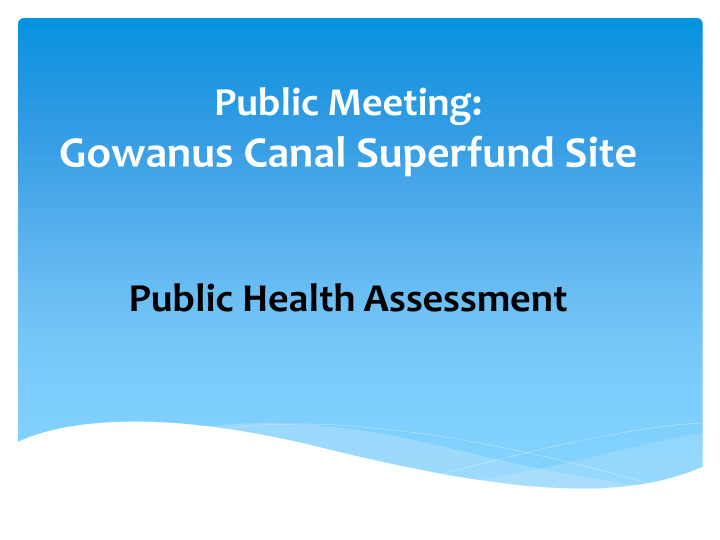



Public Meeting: Gowanus Canal Superfund Site Public Health Assessment
Prepared by: New York State Department of Health (DOH) Under a cooperative agreement with: Agency for Toxic Substances and Disease Registry (ATSDR)
Presenters DOH Chris Doroski – Gowanus Canal Project Manager ATSDR Leah Escobar, Region 2 Representative
What is ATSDR ? Atlanta-based federal Public Health Service agency created by the Comprehensive Environmental, Response, Compensation, and Liability Act of 1980 (CERCLA), or “Superfund Law” Our top priority is to protect people from exposures to (contact with) hazardous chemicals We build and apply the best science to understanding and preventing people’s exposure to toxic chemicals Educate people about exposures to toxic chemicals and about the public health assessment process Work with DOH under a cooperative agreement To determine if people are being exposed to chemicals at levels that might cause harm
Why are we here today ? To explain who we are and how we support EPA, NYS DOH and the Gowanus Canal Superfund site community To share information about the public health assessment process To listen to you and answer your questions
PHA Process
Public Health Assessments Written for a specific site – Gowanus Canal Limited to public health implications of the site itself Defined in the NPL listing – Creek body and its tributaries PHAs are not health studies PHAs are not risk assessments (EPA does them) PHAs answer how can people contact site contaminants? are people contacting site contaminants? how could people be affected by the contaminants?
Data Where did we get the information? USEPA Site Investigation National Grid Investigation of the Canal What we didn’t use….. Inactive Hazardous Waste sites Along the creek were not used. Terrestrial sites are not part of the USEPA defined site. May not represent Creek-Wide conditions.
Elements of Exposure What are the Elements? Contaminant Source. Environmental Media & Transport Mechanism. A Point of Exposure. A Route of Exposure. People who are being exposed.
Conclusions: Swimming could Harm People’s Health Bacteria Exposure Physical Hazards Recreational Boating is not expected to Harm People’s Health – No complete exposure pathway Use caution and wash afterward Eating fish and Crabs could Harm People’s Health Follow Fish Advisory Air Canal is not contributing to air quality of the community
Fish • DOH Fishing Advisory – Upper Bay of New York Harbor – Specific Guidelines regarding consumption. • Please visit: – http://www.health.ny.gov/publications/2784.pdf – http://www.health.ny.gov/publications/2796.pdf
Women Under 50 & Children Under 15 Women Over 50 & Men Over 15 American eel don't eat DEC regulations prohibit the harvest/possession of American eel for food . Atlantic don't eat up to 1 meal/month needlefish Blue crabs don't eat up to 6 crabs/week don't eat tomalley don't eat tomalley Bluefish don't eat up to 1 meal/month Carp don't eat up to 1 meal/month Channel catfish don't eat don't eat Gizzard shad don't eat don't eat Goldfish don't eat up to 1 meal/month Rainbow smelt don't eat up to 1 meal/month Striped bass don't eat up to 1 meal/month White catfish don't eat don't eat White perch don't eat up to 1 meal/month Other fish not listed don't eat up to 4 meals/month
Contact us Fact Sheet, document, comment form: http://www.health.ny.gov/environmental/investigation s/newtown/ DOH Questions: Chris Doroski (518) 402-7880 ATSDR Questions: Leah 732-906-6932 Comment: email BEEI@health.state.ny.us
Recommend
More recommend